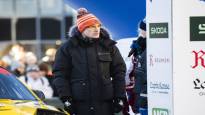The rally car is approaching two hundred between the benches. Map reader Alexandre Corian the read note has been accurate. Driver Adrien Fourmaux knows exactly what is waiting behind the bend turning gently to the left: a long straight.
This is also true. Still, the driver pair is completely surprised.
You can watch the situation in the video above.
The moment was only fleeting, but even more dramatic. Fourmaux only barely managed to pass with his Ford Ott Today too of the slowly crawling Hyundai.
Fourmaux and Tänak turned their car to the side almost simultaneously at the very last moment. A terrible accident was avoided mostly thanks to the reaction abilities of the drivers and pure luck.
No wonder Fourmaux has insisted that something should be done, and something similar should not happen again.
Toyota team manager Jari-Matti Latvala however, the situation would have been completely avoidable with existing means. In this story, he tells how.
First, we just have to open up how the situation ended up in the end.
Tänak crawled with the power of a hybrid
The whole skein started when Tänak “polluted the benches†.
The crash broke the Hyundai’s radiator, but the rally1 car’s electric motor enabled the Estonian to continue his journey – albeit with difficulty.
It was this crawling that caused the dangerous situation: Tänak and the cart Martin Järveojan the car became a slow-moving obstacle for the special test.
– When you, as a driver, drive as fast as you can, you can never assume that a car will come from behind the bend, so to speak, against Edelle, Latvala emphasizes.
If the car had gotten stuck in the bank, the situation would probably have been avoided.
Of the two, at that time Tänak would have stayed to dig out the car, while Järveoja would have hurried to the side of the road on foot to warn those coming behind with a warning triangle and an OK sign. Before this, they would have communicated with the warning system in the car that they were okay.
Seeing the sign, Fourmaux would have known that the two were fine, and thanks to the warning, he would have understood to slow down and thus avoid the car in time.
However, he could have already known all this in advance, because the system in the car could have been informed that the car driving ahead has stopped short.
The method of operation is more than familiar to drivers, teams and rally organizers. The same formula repeats itself from one race to another, because there are never any pitfalls or other interruptions in rallies.
When one of these precautions is forgotten, the consequences can be disastrous. An example of this was also seen in Sweden, when Fourmaux’s teammate Gregoire Munster got stuck on the project on Saturday.
– Fourmaux went close to another car there as well. The pair of drivers who got out did not act correctly in the situation, because they were both digging the car. The second one was not 100 meters away to give a warning, as it should be, Latvala points out.
Tänak could have been warned
But what to do when the car does not stop for a special test, but moves dangerously slowly there?
The parties involved in this did not know how to react quickly enough in Sweden. The emergence of a dangerous situation showed a deficiency in the security awareness of the World Series.
Basically, you can’t send a message to the car if it hasn’t stopped. Radio communication between the team and the driver pair during the special test has been forbidden for a long time under threat of punishment.
However, Jari-Matti Latvala reminds us of one important exception. According to Latvala, you can always be connected when it comes to security.
For one reason or another, this possibility was not utilized in the case of Fourmaux and Tänak. It is clear that neither the teams nor the rally organizers nor the driver team fully understood how to act.
Instead of pointing out the culprits, it is more important to learn from the case. There is reason to lower or at least specify the threshold for communication.
The only thing that is certain is that it is difficult to see from inside a moving car when the car behind is approaching.
– It is difficult to see out of the mirror for many reasons. I remember situations from my own career where the karter has calculated the time to when the car coming from behind could be passing. In addition, the driver always primarily tries to reach the finish line whenever possible, Latvala reminds.
This is how the warning system could be developed
In addition to the radio connection, information can be transmitted to the driver pair in other ways as well. Most typically, this happens in so-called red flag situations, when information about the suspension of the special test is shown on the screen in the car.
Viusu also uses the same system to warn of overtaking situations. This is precisely why Latvala hopes the World Rally Championship will refine its operating methods.
He also presents a development idea for the system itself.
– The system could also be developed so that it would automatically recognize if the car driving ahead is at a certain distance. It should be technologically possible, Latvala thinks.
In his career, Latvala himself has driven in an era when it was allowed to be connected to the car all the time. This naturally eased situations where the car coming behind had to pass for one reason or another. In addition, information about intervals, for example, was passed on to the motor association.
– I liked the breaks myself. That’s how you instantly knew when to squeeze a little more. Of course, it was then easier for the driver leading the rally to control the situation during the special test, Latvala describes.
